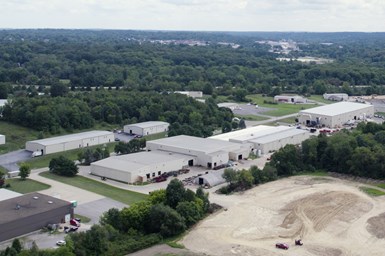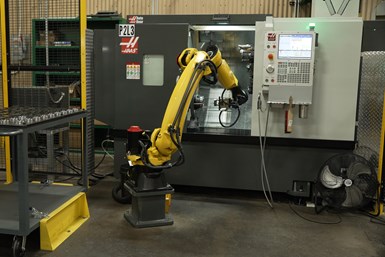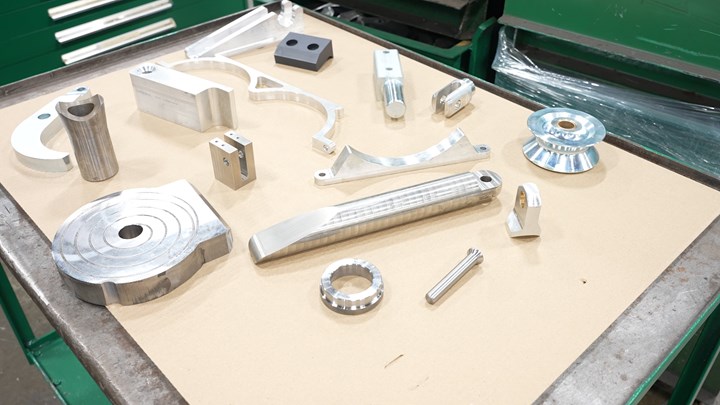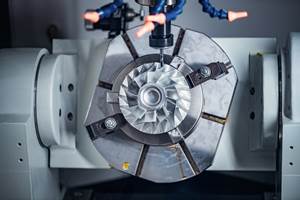Leo Hickey founded Hickey Metal Fabrication in 1942 as a one-man heating and tooling company. Later, his son Robert took over and moved the company to roofing and commercial building services. Over the next few generations of Hickey family ownership the business has slowly transitioned to metal fabrication.
The company produces large numbers of parts out of steel and aluminum ranging from 11-gauge to two inches thick using welding, laser-cutting, bending, punching and other processes, serving a variety of end markets, with its largest customer in the towing and recovery industry. The company also has a robust machine shop, where it has experimented with numerous forms of automation to meet customer demand.
Hickey Metal Fabrication is located in Salem, Ohio, and consists of seven facilities making up 400,000 square feet. The company serves numerous end markets including the architecture, towing and recovery, and fitness industries. Photo Credit: Cinemanix
Hickey Metal purchased its first machine tool in 1999 to improve the production of its welded assemblies, not to produce independent parts for sale. Since then, the company has expanded to 16 CNC milling machines and 14 lathes that produce components for the company’s fabrication business. Over time, the company has developed numerous approaches to automating the variety of parts needed for its final assemblies, weighing the benefits of different strategies and the needs of different parts — an approach that has a lot to offer for other machine shops.
Putting CNC Lathes to Work
Hickey Metal began machining parts for its fabricated products as a quality-control measure. “If it’s going on a part we’re making, we want to machine it,” says Vice President Adam Hickey, a fourth-generation co-owner of the business.
However, feeding parts to the many fabrication lines on the Salem, Ohio, campus has meant developing a robust, high-production machine shop equipped to provide component parts in large quantities. “For the most part, the machine shop produces bushings and pins in large enough quantities for fabricating,” says Hickey. “But we also have a variety of parts in different sizes that need machined features.”
This Haas ST-25Y uses a Haas bar feeder and a part catcher from Royal Products. The company uses a similar setup on most of its lathes, as it enables them to produce parts in both the quantity and variety needed to feed its high-production fabrication business. Photo Credit: HFO Trident Machine Group
Most of the machines are Haas lathes and vertical mills, with a handful of machines from other brands including Mazak and DMG MORI. Six of the lathes are equipped with Haas bar feeders and Royal Products Rota-Racks to catch parts coming off the machines, providing a large share of the production of pins and bushings.
This Haas ST-25Y cell is attended by a FANUC robot arm. While bar-fed cells are useful for most turned parts, the shop uses this cell for larger parts and parts with two-sided cutting. This enables the shop to keep production high for parts that don’t fit well with the company’s bar feeders. Photo Credit: Cinemanix
One cell, however, eschews the bar feeder in favor of a robot arm from FANUC. The robot is paired with a Haas ST-25Y with a 3.25-inch spindle and sub-spindle.
Like the other lathes, this cell also primarily handles bushings and pins, but specializes in parts incompatible with bar feeders. Thicker parts, for example, can be too large for the shop’s bar feeders, and some pins are too long or heavy for the part catchers. “The robot is great for larger parts and parts that get two-sided cutting,” Hickey says.
Even if the robotic cell cannot match the production speed of a bar feeder, it serves as a flexible way to automate production of parts whose features make bar feeders untenable. But even limiting the robotic cell to parts that the bar feeders cannot handle, there is a ton of demand for it. “We have six parts running through this machine, and we’re at capacity.”
Hickey Metal had considered cobots, but the level of production made them unfeasible. “Cobots are just too slow for what we need, and we had experience programming FANUCs from our welding robots,” Hickey says. “The guy running the machine was able to pick it up in a week.”
In fact, this robotic cell has been such a success that the company added a second robotic cell this year. The second cell incorporates a Haas ST-30Y lathe
While bar feeders can handle the majority of the high-production turning at the shop, and the robotic cells can manage the larger and more complex turned parts, Hickey Metal looked to another approach for automating milled parts.
Hickey Metal produces complex weldments that require many different parts, most of which the company tries to produce in-house to avoid supply problems. Parts range from bushings and pins to flat sheet metal parts with milled features to massive workpieces that require days of machining time. Photo Credit: HFO Trident Machine Group
It’s Milling Time
Many parts that go into Hickey Metal’s weldments require milled features. The machine shop has six Haas and five Mighty Viper VMCs, as well as a Mazak and a Chevalier. The largest mill is a Mighty Viper PRO-3210, which has a work area of 80.5 × 124 inches and machines large workpieces for the company’s biggest fabrications. For example, it prepares sliders for tow trucks that must attach to a rotator with 160 pounds of weld wire. All mating surfaces need machined within a tolerance of 0.04 inch, which takes seven days to finish due to the part’s size. For obvious reasons, this cell has been a low priority for automation, but the shop has had success automating other milling machines.
This Haas VC-400 uses a dual-pallet system to keep production running smoothly. According to Hickey, the dual-pallet approach is ideal for jobs with six-minute cycle times, as that leaves plenty of time for the attendant to prepare the next workpiece. Photo Credit: Cinemanix
Two of the Haas VMCs use palletized automation systems to produce parts at higher volumes. The VC-400 uses a dual-pallet system, while the VF-2SSYT is equipped with a three-pallet pool. “Compared to robots, pallet pools let us set up multiple jobs parallel to production,” says Hickey. “It’s better to set up four jobs while the tool is cutting than pause production to get the new part loaded.”
Many of the parts ending up on these palletized machines are ⅝- and ¾-inch plates that require some combination of milling, drilling, tapping and countersinking. The flat geometry of the parts reinforced the decision to go with pallets over robots, as robotic grippers can cause slight bowing in some flat parts.
Success with these pallet systems has yielded such positive results that the company has recently purchased a pair of Midaco pallet changers to further improve throughput for its milling machines.
Choosing whether a job goes on the the dual-pallet system or pallet pool is relatively simple. “The A/B pallet is good for high-volume parts with roughly six-minute cycle times,” Hickey says. “This gives us plenty of time to switch out the completed part and get the next one in.”
This kind of careful consideration – paying attention to the features, shape, cycle time and volume – is vital when planning out automation. Are your parts right for robots? Is the ease of working with a cobot worth the slower movements? Are you dealing with enough variety or volume to justify a pallet pool? Hickey Metal demonstrates that taking the time to plan your machining cells based on the needs of the parts can yield excellent results.
Related Content
How to Successfully Adopt Five-Axis Machining
While there are many changes to adopt when moving to five-axis, they all compliment the overall goal of better parts through less operations.
Read MoreCNC Machine Shop Honored for Automation, Machine Monitoring
From cobots to machine monitoring, this Top Shop honoree shows that machining technology is about more than the machine tool.
Read MoreWhy Go Five-Axis: Machine Types and Benefits
Even as the benefits of five-axis machining stack up year by year, the barrier for entry crumbles.
Read MoreHigh RPM Spindles: 5 Advantages for 5-axis CNC Machines
Explore five crucial ways equipping 5-axis CNC machines with Air Turbine Spindles® can achieve the speeds necessary to overcome manufacturing challenges.
Read MoreRead Next
3 Mistakes That Cause CNC Programs to Fail
Despite enhancements to manufacturing technology, there are still issues today that can cause programs to fail. These failures can cause lost time, scrapped parts, damaged machines and even injured operators.
Read MoreThe Cut Scene: The Finer Details of Large-Format Machining
Small details and features can have an outsized impact on large parts, such as Barbco’s collapsible utility drill head.
Read More














.png;maxWidth=300;quality=90)









.png;maxWidth=300;quality=90)











